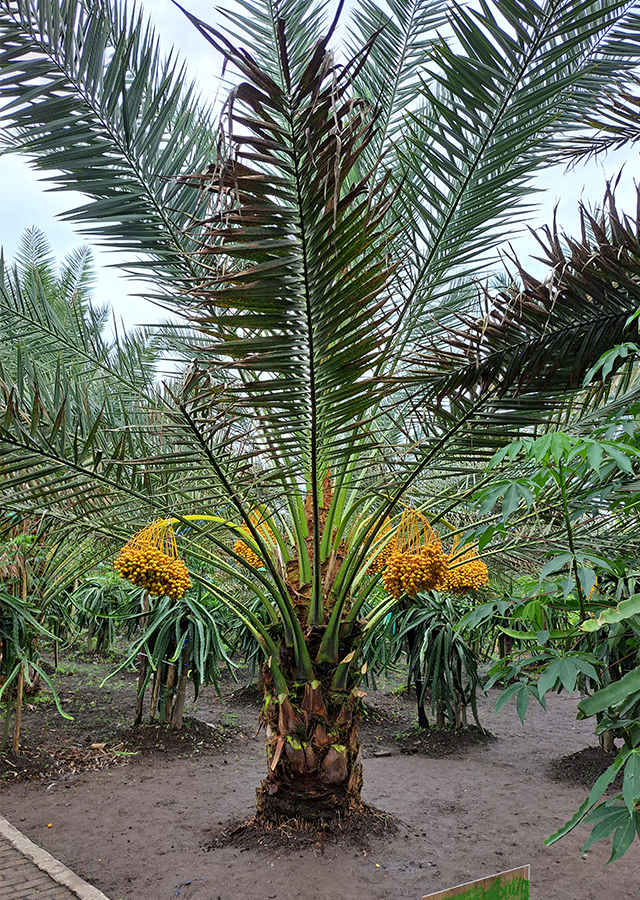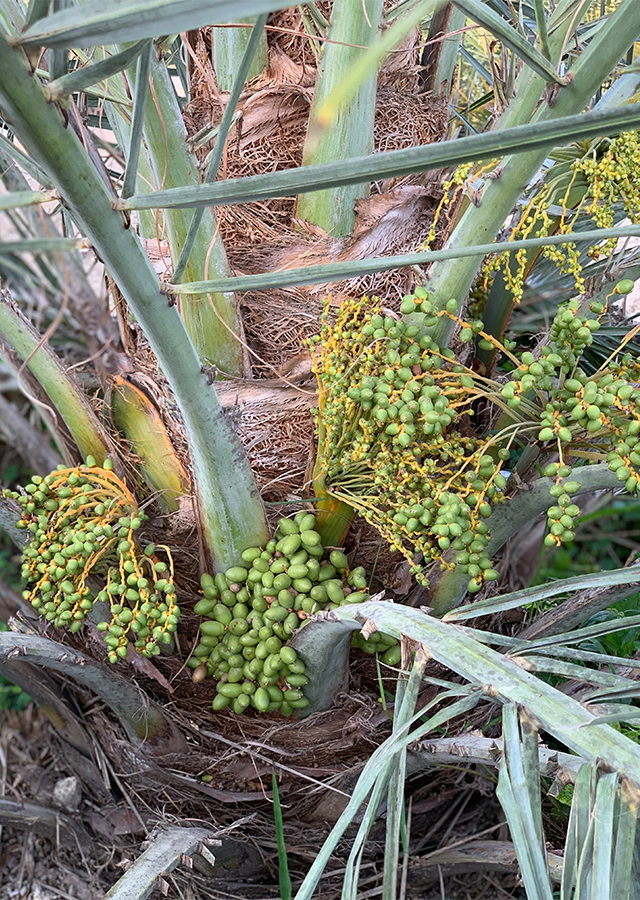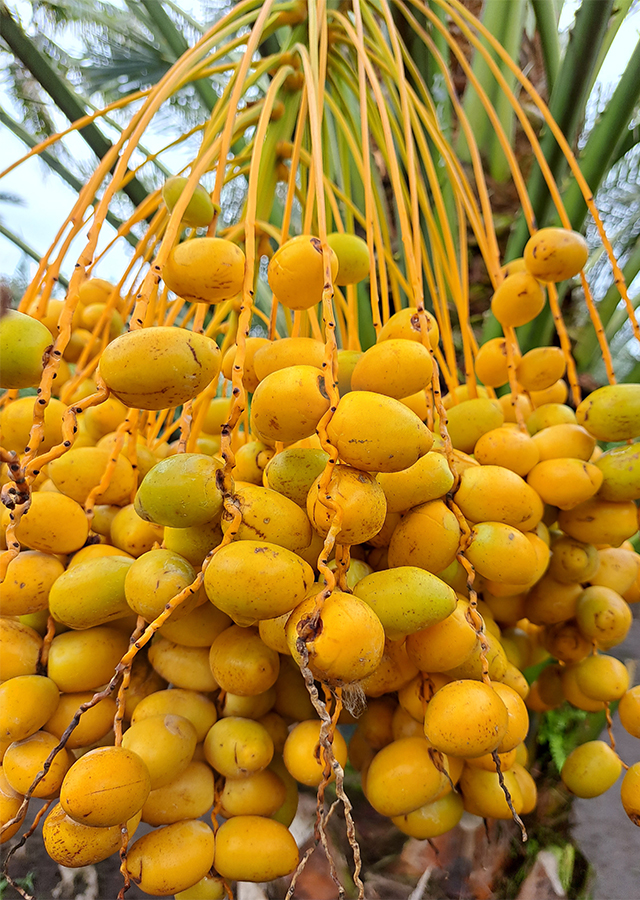Date Palm
Phoenix dactylifera L.
Arecaceae
Location in our garden
Orchard



Synonym
Palma dactylifera (L.) Mill.
Phoenix excelsior Cav.
Zamia pallida Salibs.
Habitus
Palm. A single-stemmed, evergreen palm tree growing 15 - 40 m tall
Part Used
Seeds
Fruit
Latex
Growing Requirements
Full Sunshine
Habitat
Riverbanks
Terrestrial
Overview
Dates are believed to be a plant that grows in three places, namely the banks of the Nile, the Euphrates in Ancient Egypt and Mesopotamia. It is considered a native plant of the countries around the Arabian Gulf. The Arabs know it as the 'Tree of Life', as it is considered one of the oldest cultivated fruit trees and has many uses. It has been cultivated in the Middle East since at least 6000 BC. Dates are the most popular tree, especially in arid regions such as West Asia and North Africa. This plant has various uses as an ornamental plant, a fruit-producing plant, a vegetable (apical shoot), a source of fiber, a source of material, a medicinal plant, a plant for reforestation of land affected by salt (in the Mediterranean region), an ingredient in construction. Dates produce fruit that can be consumed fresh, dried or used to add sweetness to various foods. It is usually the main meal when breaking the fast and is believed to be able to instantly replenish energy and revitalize the body. Various parts of this plant are also widely used in traditional medicine to treat various disorders. Based on research, it is known that dates are potentially safe, effective and have important medicinal values and benefits. In the cosmetic industry, dates also have a variety of benefits, including the fruit, leaves and seeds that can be used as ingredients in cosmetic preparations as moisturizers, skin conditioners, emollients, skin protectors and mask ingredients. The seeds have also been used by the community to increase the growth of livestock, usually by including them in animal feed. In addition, people also usually use the leaves to make roofs and walls of huts, leaf fibers and bark to make ropes, baskets, hats, and mats, and dry leaves with rigid wooden rachis as fences.
Vernacular Names
Nakhl (Arabic), Hai zao (Chinese), Khajur (Bengali), Dattier commun (French), Echte Dattelpalme (German), Dattero (Italian), Natsume yashi (Japanese), Finikovaia pal'ma (Russian), Palmera de dátiles (Spanish), Inthaphalam (Thai), Chi Chà là (Vienamese), Hurma (Turkish).
Agroecology
Date palm is a plant of drier areas in the tropics, where it is found at elevations up to 1,500 m. Hot dry conditions are required for free fruiting, the fruit not forming very readily in cooler or moister climates. It grows best in areas where annual daytime temperatures are within the range 26 - 45°c, but can tolerate 10 - 52°c. It prefers a mean annual rainfall in the range 200 - 300 mm, but tolerates 100 - 400 mm. Plants are tolerant of a range of soil types, so long as they are well-drained. Plants grow well in full sun, even when small. Prefers a pH in the range 6.5 - 8, tolerating 6 - 8.5.
Morphology
- Stems - single, slender, straight, with distinct petiolar scars.
- Leaves - pinnate, containing about 150 leaflets which have spines on the petiole. Leaflets are narrow lanceolate, stiff and grayish.
- Flowers - small, yellowish and individually borne. Inflorescences are produced between the leaves, with a single bract at the base.
- Fruits - cylindrical or oval-elliptical, with flesh surrounding the hard seed inside. Ripe fruit is golden yellow to reddish brown.
- Seeds - single, hard, brown.
Cultivation
- Propagated by seeds - pre-soak for 24 hours in warm water and sow in containers. Germination usually takes place in 2 - 3 months. Seed viability can be maintained for 8 - 15 years at room temperature.
- By division of suckers - pot up immediately into large containers and plant into permanent positions once the plant is established.
Chemical Constituents
Phenolic compounds (cinnamic acid (caffeic acid, p-coumaric acid, ferulic acid, m-coumaric, o-coumaric acid, and their derivatives such as dactyliferic acid), hydroxylated benzoic acid derivatives (gallic acid, protocatechuic acid, p-hydroxybenzoic acid, vanillic)), flavonoid glycosides (luteolin, methyl luteolin, quercetin, and methyl quercetin), flavanols (catechins, epicatechins), sterols and/or triterpenes, tannins, saponins, -amirin, alkaloids, coumarins, phytosterols and phytoestrogens, acids oleic, lauric, palmitate, caprate, myristic, myristol, palmitoleic, stearate, linoleic, and linolenic.
Traditional Medicinal Uses
- Used for fever, colds, cystitis, edema, sore throat, liver cancer, low sperm count.
- Seeds used as paste to relieve ague Gum used to treat diarrhea.
- Used as aphrodisiac.
- Egyptians have been reported to have used pollen grains to improve fertility in women.
- Middle Easterners consume the date in the morning on an empty stomach to reverse toxicity exposures.
- In Tunisia, used for constipation.
Part Used
Reference Sources
- Royal Botanic Gardens. Plants of the World Online: Phoenix dactylifera L. https://powo.science.kew.org/taxon/urn:lsid:ipni.org:names:668912-1#synonyms. 20-05-22.
- Tropical Plants Database, Ken Fern. 2021. Phoenix dactylifera. https://tropical.theferns.info/viewtropical.php?id=Phoenix+dactylifera. 20-05-22.
- Stuartxchange. 2014. Philippine Medicinal Plants: Date palm. http://www.stuartxchange.org/DatePalm.html. 20-05-22.
- N Vyawahare, R Pujari, A Khsirsagar, D Ingawale, M Patil, V Kagathara. Phoenix dactylifera: An update of its indegenous uses, phytochemistry and pharmacology. The Internet Journal of Pharmacology. 2008, 7(1).

